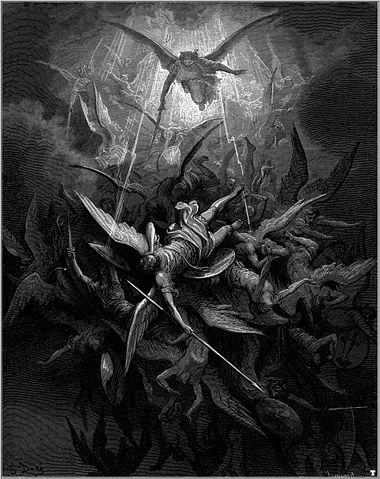Fallen angel
Fallen angels are angels who were expelled from heaven. The literal term "fallen angel" appears neither in the Bible nor in other Abrahamic scriptures, but is used to describe angels cast out of heaven or angels who sinned. Such angels often tempt humans to sin.
Origin of the term
The idea of fallen angels derived from the Book of Enoch, a Jewish pseudepigraph, or the assumption that the "sons of God" (בני האלוהים) mentioned in Genesis 6:1–4 are angels. In the period immediately preceding the composition of the New Testament, some sects of Judaism, as well as many Christian Church Fathers, identified these same "sons of God" as fallen angels.
During the late Second Temple period the Biblical giants were sometimes considered the monstrous offspring of fallen angels and human women. In such accounts, God sends the Great Deluge to purge the world of these creatures; their bodies are destroyed, yet their peculiar souls survive, henceforth roaming the earth as demons. Rabbinic Judaism and Christian authorities after the third century rejected the Enochian writings and the notion of an illicit union between angels and women producing giants. Christian theology indicates the sins of fallen angels occur before the beginning of human history.
Accordingly, fallen angels became identified with those led by Satan in rebellion against God, also equated with demons.
Book of Enoch
According to 1 Enoch 7.2, the Watchers become enamoured with human women and have intercourse with them. The offspring of these unions, and the knowledge they were giving, corrupt human beings and the earth (1 Enoch 10.11–12). Eminent among these angels are Shemyaza, their leader, and Azazel. Like many other fallen angels mentioned in 1 Enoch 8.1–9, Azazel introduces men to "forbidden arts", and it is Azazel who is rebuked by Enoch himself for illicit instruction, as stated in 1 Enoch 13.1. According to 1 Enoch 10.6, God sends the Archangel Raphael to chain Azazel in the desert Dudael as punishment. Further, Azazel is blamed for the corruption of earth: 1 Enoch 10:12: "All the earth has been corrupted by the effects of the teaching of Azazyel. To him therefore ascribe the whole crime."
New Testament
Luke 10:18 refers to "Satan falling from heaven" and Matthew 25:41 mentions "the Devil and his angels", who will be thrown into Hell. All Synoptic Gospels identify Satan as the leader of demons. Paul the Apostle (c. 5 – c. 64 or 67) states in 1 Corinthians 6:3 that there are angels who will be judged, implying the existence of wicked angels. 2 Peter 2:4 and Jude 1:6 refer paraenetically to angels who have sinned against God and await punishment on Judgement Day. The Book of Revelation, chapter 12, speaks of Satan as a great red dragon whose "tail swept a third part of the stars of heaven and cast them to the earth." In verses 7–9, Satan is defeated in the War in Heaven against Michael and his angels: "the great dragon was thrown down, that ancient serpent who is called the Devil and Satan, the deceiver of the whole world—he was thrown down to the earth and his angels were thrown down with him."
Origen and other Christian writers linked the fallen morning star of Isaiah 14:12 of the Old Testament to Jesus' statement in Luke 10:18 that he "saw Satan fall like lightning from heaven", as well as a passage about the fall of Satan in Revelation 12:8–9. The Latin word lucifer, as introduced in the late 4th-century AD Vulgate, gave rise to the name for a fallen angel.
